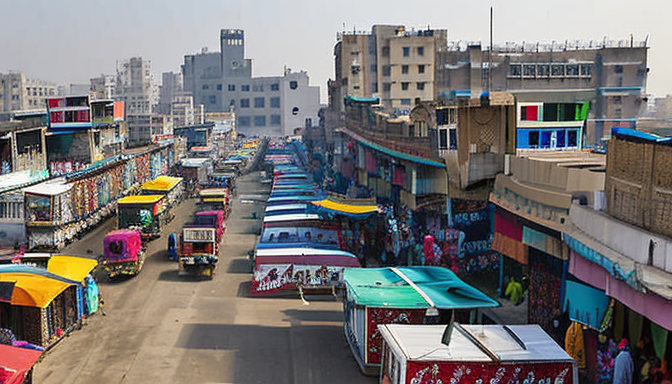Karachi, a city that pulses with life, has a rich history that tells a story of transformation. From its humble beginnings as a small fishing village, Karachi has evolved into a bustling metropolis. But how did this happen? Let’s take a journey through time to uncover the major events that shaped this vibrant city.
In the early days, Karachi was just a quiet coastal settlement. The locals relied on fishing and small trade. As time passed, the city began to attract traders from various civilizations. This influx brought with it a mix of cultures, languages, and traditions. The Port of Karachi became a critical hub for commerce, connecting the East with the West.
Fast forward to the 19th century, when Karachi experienced significant changes. The British colonial rule introduced modern infrastructure and urban planning. With the establishment of railways and roads, the city began to grow rapidly. People flocked to Karachi, seeking jobs and opportunities. This period marked the beginning of its transformation into an economic powerhouse.
By the mid-20th century, Karachi had firmly established itself as a major city in South Asia. The industrial boom attracted even more migrants, leading to a rich tapestry of cultures. Today, Karachi is not just a city; it’s a melting pot of traditions, languages, and lifestyles. Its history is a testament to resilience and adaptability, reflecting the spirit of its people.
Early Settlements and Cultural Influences
The story of Karachi begins long before it became the bustling city we know today. Picture this: a small fishing village, nestled along the coast, where the salty breeze mingled with the sounds of waves. This humble settlement, dating back to the 18th century, was a meeting point for various cultures and traders. Can you imagine the vibrant markets filled with spices and textiles? It was a melting pot of influences from the Indus Valley Civilization, the Persians, and even the Portuguese.
As time passed, Karachi evolved. By the late 19th century, it was no longer just a fishing spot; it had transformed into a significant trading hub. The British recognized its potential and developed its port. This shift attracted people from all over, leading to a diverse population. You had the Muslims, Hindus, and Christians coexisting, each adding their unique flavor to the city’s culture.
Key events shaped Karachi’s identity. For instance, the construction of the Karachi Port in 1854 marked a turning point. It opened doors to international trade. This was followed by the arrival of the railway in 1860, connecting Karachi to the rest of the subcontinent. Trade flourished, and the city grew, both in size and significance.
Throughout these changes, Karachi’s cultural landscape was enriched. Festivals, languages, and cuisines blended together, creating a unique tapestry. Imagine walking through the streets, where every corner tells a story of resilience and adaptation. This early history laid the foundation for what Karachi would become—a vibrant metropolis brimming with life and energy.

Modern Era Transformations
Karachi has seen a whirlwind of changes in the modern era. Imagine a small fishing village morphing into a bustling metropolis. It’s like watching a caterpillar transform into a butterfly—full of color and life! This transformation began in the late 19th century, when Karachi was declared a city in 1864. The British recognized its potential as a port, and suddenly, the city was buzzing with activity.
Industrialization played a crucial role in shaping Karachi. Factories sprang up, drawing people from all over the region. They came seeking jobs, dreams, and a better life. This influx of migrants brought a rich tapestry of cultures, making Karachi a melting pot of traditions. But it wasn’t all smooth sailing. With rapid growth came challenges. The city faced issues like overcrowding and inadequate infrastructure.
By the mid-20th century, Karachi had transformed into an economic powerhouse. It became the financial heart of Pakistan, hosting major banks and corporations. The port of Karachi became one of the busiest in the region, facilitating trade and commerce. This period also saw the rise of educational institutions, nurturing a generation of thinkers and leaders.
However, the socio-political landscape was turbulent. From political unrest to economic disparities, Karachi’s story is filled with ups and downs. Yet, the resilience of its people shines through. They adapted, innovated, and continued to push forward, making Karachi a symbol of hope and progress.
In summary, Karachi’s modern era is a tale of transformation, filled with challenges and triumphs. It’s a reminder that change is constant, and with it comes the opportunity to grow and evolve.
Frequently Asked Questions
- What is the historical significance of Karachi?
Karachi is a melting pot of cultures and histories, evolving from a small fishing village to a bustling metropolis. Its strategic location has made it a vital trade hub, influencing its growth and development over centuries.
- How did early settlements shape Karachi?
Early settlements in Karachi were influenced by various civilizations, including the Greeks, Persians, and Mughals. These interactions fostered a rich tapestry of cultural and economic exchanges that laid the groundwork for the city’s future.
- What transformations did Karachi undergo in the modern era?
In the modern era, Karachi experienced rapid industrialization and urbanization, transforming into one of South Asia’s major economic hubs. This shift brought diverse populations together, creating a dynamic socio-political landscape.
- What role does Karachi play in South Asia today?
Today, Karachi is a key player in South Asia’s economy, known for its bustling ports and industries. It serves as a gateway for trade and commerce, continually shaping the region’s economic landscape.